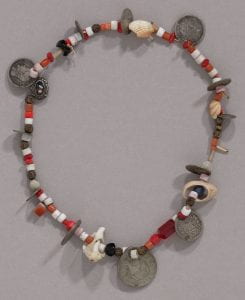
How you experience art is subjective. The ideas, opinions, and knowledge that you bring to viewing works of art or objects is rooted in your own history and life experience. That unique experience offers an opportunity to connect with what you see in interesting and engaging ways.
At the Hood Museum of Art, educators often ask visitors to look carefully at works of art and consider these questions: What do you see? What materials make up the work? What is it about? Viewers begin to interpret based on their personal knowledge, whether founded in education or experience. It becomes an entry point through which to explore the work—to connect to it. For this blogpost, I decided to explore an area of the collection rarely looked at and one I can bridge connections to in a personal way.
Numbering over three hundred*, the Hood Museum has a collection of objects and materials from Mayan and Guatemalan culture, which range from terracotta pots and sherds to tourist kitsch, colorful textiles, and handmade items. As a Guatemalan transracial adoptee who was raised in rural New Hampshire, I was both encouraged and intrigued by this discovery. It made me wonder: How did these objects find their way into the care of this museum?
The quick answer is that Dr. Charles H. Tozier, whose son was Class of 1933, amassed more than half the collection on an expedition to Guatemala in 1940, which was partially funded by Dartmouth. His goal was to gather “specimens” and “handiwork” from Guatemala for the nascent College Museum*. Several other donations were made to the collection over the years, most in the 1930s-1950s. However, the collection has largely gone unnoticed* and unresearched. While I cannot claim to be a knowledgeable researcher of my own heritage, I was hopeful that I could make new connections to my place of birth through this collection.
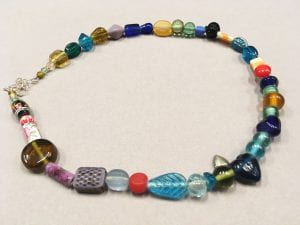
While scanning full storage shelves of Guatemalan objects, a necklace caught my eye (fig. 1). At first glance I immediately thought of a personal experience, one that had nothing to do with the traditional context of the object (which I knew literally zero about). It reminded me of a necklace that I own. One that was strung together at my baby shower—each bead placed on the strand came with a well wish from friends and family (fig. 2). This was my first connection to the object; my entry point.
The necklace in the Hood Museum’s collection has a mixture of beads but it also has Guatemalan coins. When I noticed that, I thought of my second connection: a film by Sergei Eisenstein titled ¡Que viva México!, which I had viewed as part of Brooklyn Museum’s exhibition, Frida Kahlo: Appearances Can Be Deceiving (February 8–May 12, 2019). The film focused on Mexico’s culture and politics and included a segment on marriage and courtship. One caption in the film read, “here the girls go to work early and save every copper . . . to acquire a necklace of gold coins . . .” [1] While the coins on this necklace were not gold, perhaps they had something to do with a similar marriage tradition?
I also found it interesting that the object ID tag on the necklace said it was “probably Guatemalan.” The object record in the museum’s database explains that this necklace was “found in collection” and so the provenance is unknown. It is a common issue that older collections have. That is, sometimes things enter the building and do not get properly recorded, moved over time, or lost in the shuffle—only to turn up years later. Here, I found a third connection to this necklace: it was “adopted” into the collection. With these three initial connections, I felt this object provided me with an opportunity to do some research and learn more about Guatemalan culture and my heritage.
In the Mayan language of K’iche’ (also spelled Quiché) the word necklace is chachal. Chachales originated in Mayan culture prior to Hispanic contact over five hundred years ago. As Lee Price Arellano has found in her research, “necklaces originally worn by the Mayans were made of sea shells, animal teeth, and greenstones, including jade . . .”[2] Chachales were originally made with red coral, native to the Guatemalan coast, and were symbols of wealth and status. Upon contact with Europeans, red beads were introduced by colonial traders and took the place of the coral, which was becoming a rare material.[3] Later, coins would be added to these chachales as a new kind of status symbol.
The chachal in the Hood Museum’s collection contains several of these elements. It has many red beads, and upon close inspection, the white beads used to be both blue and green, as the original color remains on the inside of the bead (fig. 4).
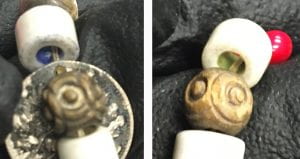
As journalist Carlisle Johnson notes, “as time went on in Guatemala, different areas of Guatemala adopted different colors of beads”. [4] It also has bugle beads (tubular cut glass beads), which have been manufactured in the Czech Republic since the 1860s.[5] There is one red and white variegated bead that is square in shape and has a small bit of chain connected to it. This indicates that it was likely attached to something else before being added to this chachal. There are four shells of various types, which would have been common in older Mayan chachales.
Following tradition, this chachal is adorned with eleven silver coins that range in date. The earliest is dated 1829, and the latest is from 1899. There are two Guatemalan pesos featuring Rafael Carrera, dictator of Guatemala from 1844–48 and 1851–65. There are several 1/2 Real coins, and two 25 Cent pieces. The oldest is a 1/2 Real coin from Zacatecas, Mexico. It’s also typical for Guatemalan chachales to have a dominant coin, cross, or charm. This one appears to be an academic medal of some kind. The obverse depicts a globe sitting atop a pile of books flanked by a drawing compass and, what I presume to be, a laurel branch. Rays of light shine down on the objects. The verso says “AL MERITO 1A CLASE” (fig. 5).
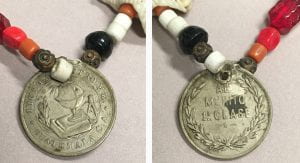
It leads me to wonder if the original owner of this chachal was the recipient of the academic medal, or perhaps it was a family member? Being a central object to the chachal, perhaps education was important to the owner. Were the coins passed down through a family? Maybe, the chachal was once hung in a market booth, waiting for a tourist’s eye to rest on it? It is doubtful we will ever know the full story but with the various beads, coins, and shells, this Guatemalan chachal is certainly a blend of traditional Indigenous and global influences.
Although I was drawn to this collection and the chachal because of my personal history, it served as an entry point to spend time looking closely at an object that had gone unnoticed and to explore a very specific aspect of Mayan culture unknown to me. I now have a more layered experience and connection to the object and the history of the collection. We all have different entry points and sharing those experiences and histories can offer new perspectives that engender ideas and expand on what we know and what we hope to learn.
This post was authored by: Nicole Gilbert, Assistant Registrar
ABOUT THE AUTHOR
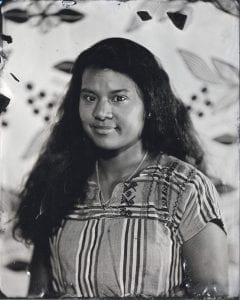
Nicole Gilbert, Assistant Registrar, is responsible for supporting and maintaining the collection through cataloging, records management, and best practice for the care of the art and objects. Coordinator for collections located on campus, Nicole also assists with classes using the Bernstein Center for Object Study and photographing the collection. Prior to joining the registrars’ department, Nicole was the exhibitions coordinator at the Hood for seven years. Nicole holds a M.A. in liberal studies from Dartmouth College and a B.A. in art history from the University of New Hampshire.
NOTES
*Please note, this number does not include a collection of lantern slides documenting the country and its people or other photography in the collection with a Guatemalan focus.
*Several Boston area newspapers featured this donation to the Dartmouth College Museum—not yet the Hood Museum of Art—as well as The Dartmouth (see list below).
- “Dartmouth Museum to Get Guatemala Indian Collection.” Boston Globe. October 4, 1940.
- “Summer Trip to Guatemala To Benefit Dartmouth College.” Boston Transcript. October 5, 1940.
- “Display Collection of Indian Handwork in College Musuem.” The Dartmouth. Wednesday, October 16, 1940.
- “Guatemalan Indian Study For College.” Boston Christian Science Monitor. October 26, 1940
1 ¡Que viva México! a film by Sergei Eisenstein (1931) Black and white, 35mm, 90 mins.
Can be viewed here: http://www.thethird-eye.co.uk/viva-mexico-by-sergei-eisenstein/
2 Arellano LP. Chachales of Guatemalan Mayan Indians. Ornament. 2000;24(1):30-33. Accessed January 15, 2021, source link.
3 Johnson, Carlisle. “Guatemala’s Unique Chachales.” Revue Magazine, 1 Feb. 2009, source link.
4 Johnson, Carlisle. “Guatemala’s Unique Chachales.” Revue Magazine, 1 Feb. 2009, source link.
5 Weller, Anna. “Guide to Bugle Beads Including History, Sizing, Shapes & Coatings.” Big Bead Little Bead, Copyright © 2008-2015, source link.
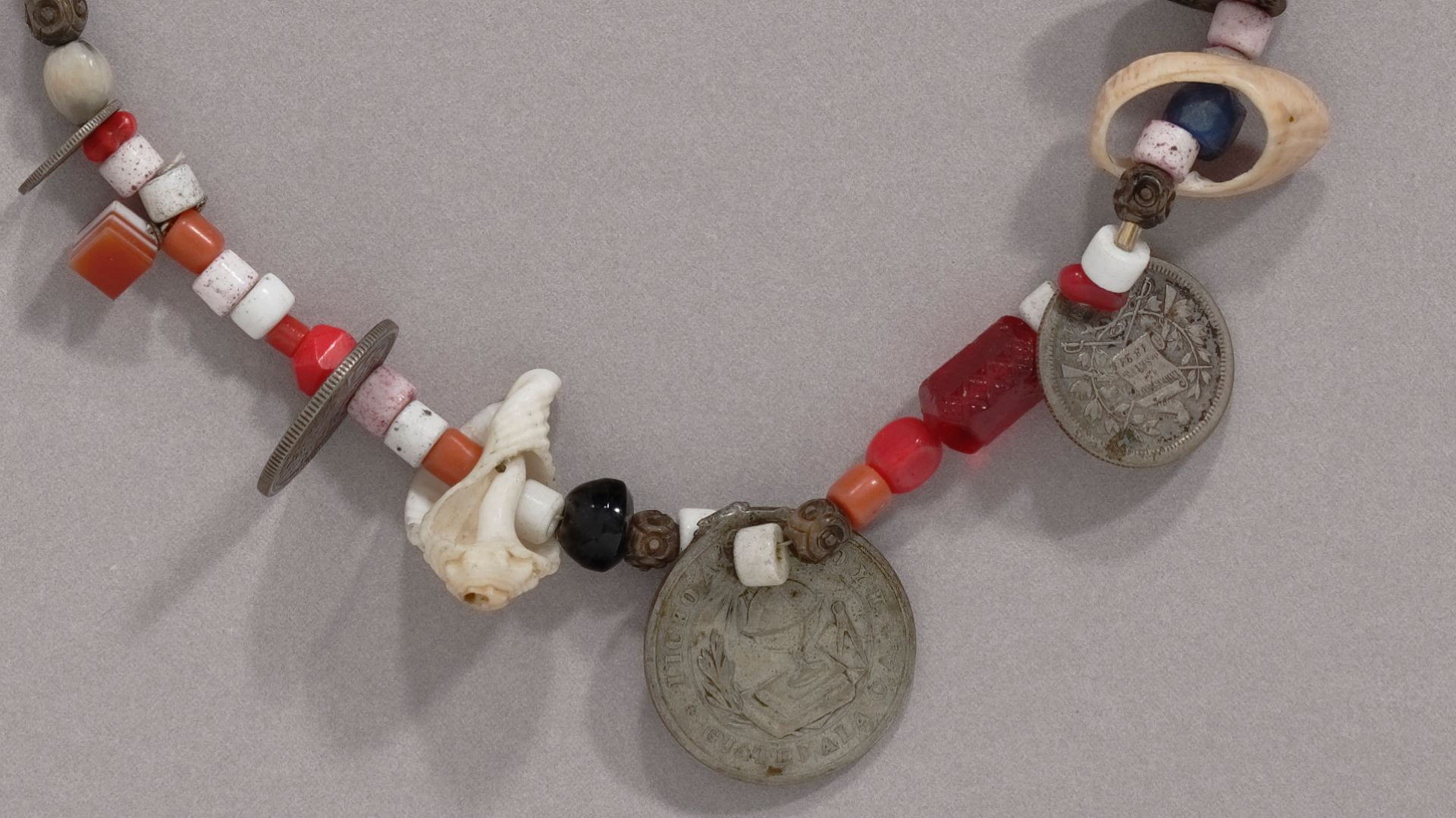
Comments are closed.